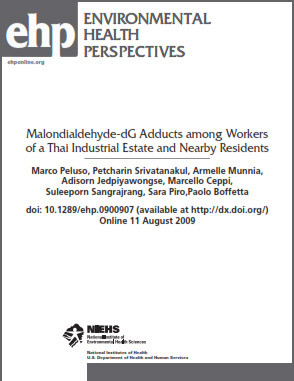Publications

Pollutant Release and Transfer Register – Important Tool for NGOs Working on Chemicals
Powerpoint Presentation from the IPEN General Assembly, 22 October 2010
By RNDr. Jindřich Petrlík, Arnika Association

Literature Review: The Impact of Mercury on Human Health
Mercury Disability Board, 2010
The approach used by the Mercury Disability Board to assess whether or not an applicant has signs or symptoms consistent with mercury poisoning was designed based on the state of science and knowledge of the impact of mercury on human health in the 1980s. In 2009 the Board commissioned a review of the literature to determine if there is new knowledge that might in some way inform the Board's work. Proposals were sought from senior scientists who have published in this field in the scholarly literature. Drs. Laurie Chan and Donna Mergler were engaged in July, 2009 to complete the work.

Malondialdehyde-dG Adducts among Workers of a Thai Industrial Estate and Nearby Residents
National Institutes of Health, U.S. Department of Health and Human Services, 11 August 2009
Humans living near industrial point emissions can experience high levels of exposures to air pollutants. Map Ta Phut Industrial Estate in Thailand is the location of the largest steel, oil refinery and petrochemical factory complexes in the South–Eastern Asia. Air pollution is an important source of oxidative stress and reactive oxygen species, which interact with DNA and lipids, leading to oxidative damage and lipid peroxidation, respectively.

Mercury in Fish, A Global Health Hazard
Zero Mercury Working Group and Mercury Policy Project, 10 February 2009
Methylmercury contamination of fish and fish-eating mammals is a global public health concern. The risk is greatest for populations whose per capita fish consumption is high, and in areas where environmental pollution has elevated the average mercury content of fish. But methylmercury hazards also exist where per capita fish consumption and average mercury levels in fish are comparatively low. In cultures where fish-eating marine mammals such as whales and seals are part of the traditional diet, methylmercury in these animals adds to total dietary exposure.

DNA adduct formation among workers in a Thai industrial estate and nearby residents
By Marco Peluso, Petcharin Srivatanakul, Armelle Munnia, Adisorn Jedpiyawongse, Aurelie Meunier, Suleeporn Sangrajrang, Sara Piro, and Marcello Ceppi, and Paolo Boffetta, 1 November 2007
The genotoxic effects of air pollutant exposures have been studied in people living and working in Map Ta Phut, Rayong province, Thailand, a site where is located the Map Ta Phut Industrial Estate (MIE) one of the largest steel, refinery and petrochemical complex in the South–Eastern Asia. This was done by the conduction of a transversal study aimed to compare the prevalence of bulky DNA adducts in groups of subjects experiencing various degree of air pollution.

Ignorance is Toxic… Double Standard at Map Ta Phut
Published by Campaign for Alternative Industry Network (CAIN), January 2007
Large parts of Thai society are unaware of dangers that come along with the rapid industrial development of the country. While a company’s facility will have numerous impacts on its surrounding, many of those are hidden and require public disclosure in order for people to know what their concerns should be. Exclusion from the knowledge-circle cripples people’s ability to safeguard their environment and the vitality of their communities. This has been recognized by the principle of “Right to Know” (RTK).

Analysis of Water Quality around Large Anthropogenic Emissions Sources in Eastern Thailand
By Arpa Wangkiat, Department of Civil and Environmental Engineering, Rangsit University, November 2006
The study evaluated variations in elemental compositions of water quality affected by large anthropogenic emission sources in Eastern Thailand: Map Ta Phut Industrial Estates which have housed over 90 industrial facilities including oil refineries, petrochemical and chemical facilities and hazardous waste landfills and treatment facilities. Eighty water samples were collected from water-well of 25 communities in Map Ta Phut during November 2005 and February 2006.

Learning from Pollution Campaign Experiences in Japan
Paper prepared for Asian Public Intellectuals Workshop, 26-30 November 2006. By Penchom Saetang.
This study was conducted between March to June 2006 in Japan with personal interest as Thailand’s industrial development pattern has closely imitated Japan’s. At the same time, the Japanese government and Japanese corporations have interestingly roles in and influence on Thailand’s transformation from an agricultural-based to industrial-based economy. This is seen clearly in development of the Eastern Seaboard Development program (ESB) in the mid-1980s.

Thailand’s Air: Poison Cocktail
Exposing Unsustainable Industries and the Case for Community Right To Know and Prevention [Thailand Bucket Brigade]
By Campaign for Alternative Industry Network (CAIN), Greenpeace Southeast Asia (GPSEA), Global Community Monitor (GCM), October 2005
This report gives fresh evidence that the proposed ‘Community Right To Know Law’ and the ‘National Pollutant Release and Transfer Registers (PRTR) System’ are essentially needed along with better environmental monitoring and direct involvement of affected communities in environmental decision-making with the aim to achieve environmental justice and sustainable society.

Breathing Fire, in Their Own Words: West County Toxics Coalition’s: 20 20 Year Environmental Justice Struggle to Ban Toxic Flares
By Denny Larson, Global Community Monitor and its National Refinery Reform Campaign, 2005
In the early 1940’s, Richmond, California, became a large hub for shipbuilding as part of the World War II effort. Thousands of African Americans from the South migrated to Richmond to take advantage of the jobs and opportunity. Many settled along the less inhabited areas of the region, mainly near the fencelines of industrial developments. The largest industry was Chevron’s Richmond refinery that occupied over 300 acres in the northeast corner of Richmond. Studies have documented the proximity of African American and people of color neighbors to industrial pollution sources in Richmond.


